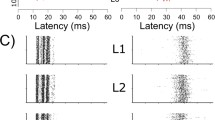Abstract.
Neuronal coding of temporal stimulus features can occur by means of delay lines. Given that neuronal activity is conducted through many parallel axons, there has to be a mechanism guaranteeing minimal temporal dispersion. We argue that plastic changes in synaptic transmission that are unspecifically propagated along presynaptic axons are a basis for the development of delay-line topologies. Furthermore, we show how two populations of afferents form a map of interaural time differences as found, for instance, in the laminar nucleus of the barn owl.
Similar content being viewed by others
Author information
Authors and Affiliations
Additional information
Received: 28 June 2002 / Accepted: 9 July 2002
Acknowledgements. The authors thank Richard Kempter and Hermann Wagner for a most enjoyable collaboration on understanding of how temporal maps can be realized through AMSL. C.L. is partially supported by the Deutsche Forschungsgemeinschaft, grant no. KL 608/10-3 and HE 3252/1-3 (FG Hörobjekte).
Correspondence to: J.L. van Hemmen (e-mail: lvh@ph.tum.de)
Rights and permissions
About this article
Cite this article
Leibold, C., van Hemmen, J. Mapping time. Biol Cybern 87, 428–439 (2002). https://doi.org/10.1007/s00422-002-0354-x
Issue Date:
DOI: https://doi.org/10.1007/s00422-002-0354-x




